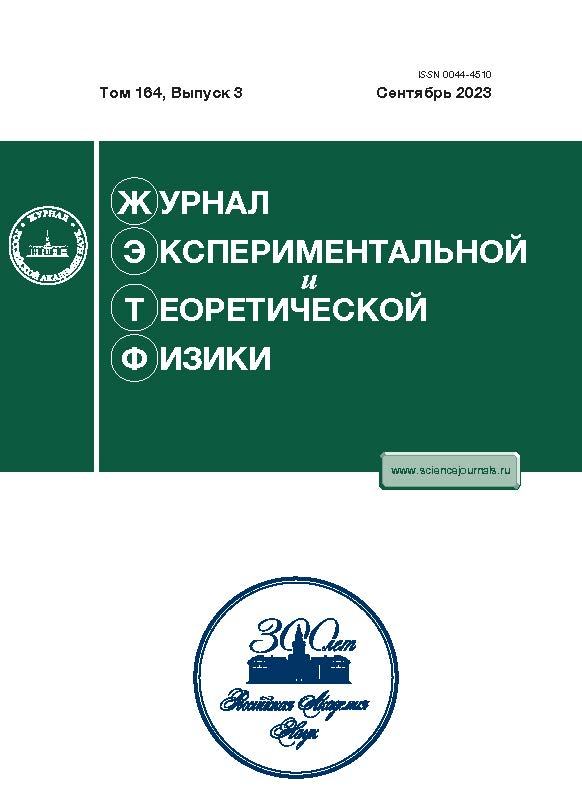Single Electron Capture in Collisions of Fast Ions with Molecular Hydrogen in the Impact Parameter Representation
- Autores: Goryaev F.F.1
-
Afiliações:
- Lebedev Physical Institute, Russian Academy of Sciences
- Edição: Volume 164, Nº 3 (2023)
- Páginas: 349-364
- Seção: Articles
- URL: https://transsyst.ru/0044-4510/article/view/653650
- DOI: https://doi.org/10.31857/S0044451023090043
- EDN: https://elibrary.ru/KCHXFJ
- ID: 653650
Citar
Texto integral
Resumo
A theoretical method for evaluating the single-electron capture (SEC) cross sections in collisions of fast ions with a ground-state H2 molecule is presented. The scattering problem for ion-molecule collisions is formulated in the impact parameter representation using the relation between the quantum-mechanical amplitude and quasi-classical impact parameter one. The capture amplitudes and corresponding probabilities of capture to (nlm) states of an incident ion are derived within the framework of the Brinkman–Kramers approximation. The general expressions for the SEC probability amplitudes to n-states, summed over l and m quantum numbers, are deduced, from which the corresponding SEC probabilities can be then calculated using a procedure of multichannel normalization. The dependence of the differential cross sections, integrated over projectile impact parameters, on the molecular orientation for charge exchange in H+ + H2 collisions is considered and compared with measurements and other calculations. Total SEC cross sections, integrated over the molecular orientations and summed over n-states for several bare and dressed ions, are calculated and compared with available experimental data and results of calculations by means of other theoretical methods.
Sobre autores
F. Goryaev
Lebedev Physical Institute, Russian Academy of Sciences
Autor responsável pela correspondência
Email: goryaev_farid@mail.ru
Moscow, 119991 Russia
Bibliografia
- H. Knudsen, H. K. Haugen, and P. Hvelplund, Phys. Rev. A 24, 2287 (1981).
- I. Tolstikhina, M. Imai, N. Winckler, and V. Shevelko, Basic Atomic Interactions of Accelerated Heavy Ions in Matter, Springer Series on Atomic, Optical, and Plasma Physics, Vol. 98, Springer-Verlag GmbH (2018).
- V. P. Shevelko, P. Scharrer, C. E. Du¨llmann et al., NIMB 428, 56 (2018).
- P. Scharrer, C. E. Du¨llmann, W. Barth et al., Phys. Rev. Acceler. Beams 20, 043503 (2017).
- Y. T. Oganessian, V. K. Utyonkov, Y. V. Lobanov, et al., Phys. Rev. C 64, 064309 (2001).
- Y. T. Oganessian and V. K. Utyonkov, Rep. Progr. Phys. 78, 036301 (2015).
- J. Khuyagbaatar, V. P. Shevelko, A. Borschevsky, et al., Phys. Rev. A 88, 042703 (2013).
- T. F. Tuan and E. Gerjuoy, Phys. Rev. 117, 756 (1960).
- P. P. Ray and B. C. Saha, Phys. Lett. A 71, 415 (1979).
- P. P. Ray and B. C. Saha, Phys. Rev. A 23, 1807 (1981).
- N. C. Deb, A. Jain, J. H. McGuire, Phys. Rev. A 38, 3769 (1988).
- E. G. Adivi, J. Phys. B 42, 095207 (2009).
- R. Shingal, C. D. Lin, Phys. Rev. A 40, 1302 (1989).
- Y. D. Wang, J. H. McGuire, R. D. Rivarola, Phys. Rev. A 40, 3673 (1989).
- Y. D. Wang and J. H. McGuire, Phys. Rev. A 44, 367 (1991).
- L. Meng, C. O. Reinhold, R. E. Olson, Phys. Rev. A 40, 3637 (1989).
- L. Meng, C. O. Reinhold, R. E. Olson, Phys. Rev. A 42, 5286 (1990).
- C. Illescas and A. Riera, Phys. Rev. A 60, 4546 (1999).
- H.F. Busnengo, S.E. Corchs, R.D. Rivarola, Phys. Rev. A 57, 2701 (1998).
- S. Halder, S. Samaddar, K. Purkait, et al., Indian J. Phys. 94, 151 (2020).
- V. P. Shevelko, J. Phys. B 13, L319 (1980).
- V. P. Shevel'ko, J. Tech. Phys. 46, 1225 (2001).
- http://cdfe.sinp.msu.ru/services/cccs/HTM/main.htm.
- D. R. Bates and R. McCarroll, Proc. Royal Soc. London A 245, 175 (1958).
- D. R. Bates, Proc. Royal Soc. London A 247, 294 (1958).
- R.M. May, Phys. Rev. 136, 669 (1964).
- R. M. Drisko, Ph.D. thesis, Carnegie-Mellon University (1955).
- A. M. Brodskiˇi, V. S. Potapov, V. V. Tolmachev, Soviet JETP 31, 144 (1970).
- V. S. Potapov, Soviet JETP 36, 228 (1973).
- S. C. Wang, Phys. Rev. 31, 579 (1928).
- S. Weinbaum, J. Chem. Phys. 1, 593 (1933).
- K. Støchkel, O. Eidem, H. Cederquist, et al., Phys. Rev. A 72, 050703 (2005).
- D. Fischer, M. Gudmundsson, K. Støchkel, et al., J. Phys. Conf. Series, Vol. 88, 012021 (2007).
- M. B. Shah, P. McCallion, H. B. Gilbody, J. Phys. B 22, 3983 (1989).
- S.E. Corchs, R.D. Rivarola, J.H. McGuire, et al., Phys. Rev. A 47, 201 (1993).
- H. Tawara, T. Kato, and Y. Nakai, At. Data Nucl. Data Tables 32, 235 (1985).
- W. Schwab, G. B. Baptista, E. Justiniano, et al., J. Phys. B 20, 2825 (1987).
- C. F. Barnett, H. T. Hunter, M. I. Fitzpatrick, et al., Atomic data for fusion, Vol. 1 (1990).
- W. Fritsch, Phys. Rev. A 46, 3910 (1992).
- S. E. Corchs, R. D. Rivarola, J. H. McGuire, et al., Physica Scripta 50, 469 (1994).
- M. E.Rudd, T. V. Go e, A. Itoh, Phys. Rev. A 32, 2128 (1985).
- M. M. Sant'anna, W. S. Melo, A. C. Santos, et al., Phys. Rev. A 61, 052717 (2000).
- I. S. Dmitriev, Y. A. Teplova, Y. A. Belkova, et al., Soviet JETP 98, 918 (2004).
- R. Phaneuf, R. Janev, and M. Pindzola, Atomic data for fusion, Vol. 5 (1987).
- W. G. Graham, K. H. Berkner, R. V. Pyle, et al., Phys. Rev. A 30, 722 (1984).
- R. Anholt, X. Y. Xu, C. Stoller, et al., Phys. Rev. A 37, 1105 (1988).
- J. Eichler and F.T. Chan, Phys. Rev. A 20, 104 (1979).
- L. F. Errea, L. Fern'andez, A. Mac'ıas, et al., Phys. Rev. A 69, 012705 (2004).
- E. C. Montenegro, G. M. Sigaud, and W. E. Meyerhof, Phys. Rev. A 45, 1575 (1992).
Arquivos suplementares










